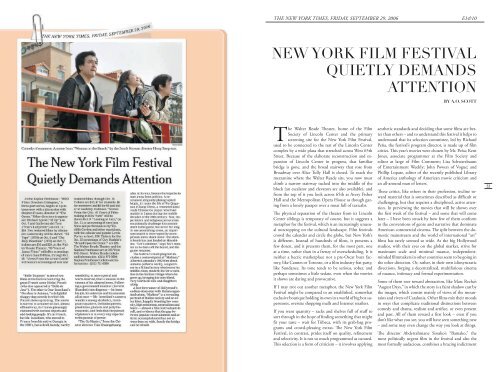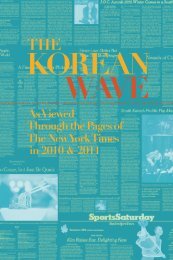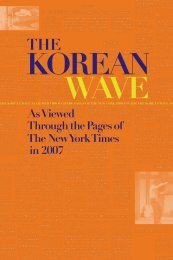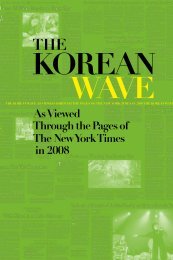The Korean Wave 2006 - Korean Cultural Service
The Korean Wave 2006 - Korean Cultural Service
The Korean Wave 2006 - Korean Cultural Service
Create successful ePaper yourself
Turn your PDF publications into a flip-book with our unique Google optimized e-Paper software.
<strong>The</strong> New York Times, Friday, september 29, <strong>2006</strong><br />
e1&10<br />
New York Film Festival<br />
Quietly Demands<br />
Attention<br />
By A.O. SCOTT<br />
<strong>The</strong> Walter Reade <strong>The</strong>ater, home of the Film<br />
Society of Lincoln Center and the primary<br />
screening site for the New York Film Festival,<br />
used to be connected to the rest of the Lincoln Center<br />
complex by a wide plaza that stretched across West 65th<br />
Street. Because of the elaborate reconstruction and expansion<br />
of Lincoln Center in progress, that familiar<br />
bridge is gone, and the broad stairway that rose from<br />
Broadway over Alice Tully Hall is closed. To reach the<br />
mezzanine where the Walter Reade sits, you now must<br />
climb a narrow stairway tucked into the middle of the<br />
block (an escalator and elevators are also available), and<br />
from the top of it you look across 65th at Avery Fisher<br />
Hall and the Metropolitan Opera House as though gazing<br />
from a lonely parapet over a moat full of taxicabs.<br />
<strong>The</strong> physical separation of the theater from its Lincoln<br />
Center siblings is temporary of course, but it suggests a<br />
metaphor for the festival, which is an increasingly unusual<br />
outcropping on the cultural landscape. Film festivals<br />
crowd the calendar and circle the globe, but New York’s<br />
is different. Instead of hundreds of films, it presents a<br />
few dozen, and it presents them, for the most part, one<br />
at a time, rather than in a frenzy of overscheduling. It is<br />
neither a hectic marketplace nor a pre-Oscar buzz factory,<br />
like Cannes or Toronto, or a film industry frat party,<br />
like Sundance. Its tone tends to be serious, sober, and<br />
perhaps sometimes a little sedate, even when the movies<br />
it shows are daring and provocative.<br />
If I may trot out another metaphor, the New York Film<br />
Festival might be compared to an established, somewhat<br />
exclusive boutique holding its own in a world of big box superstores,<br />
oversize shopping malls and Internet retailers.<br />
If you want quantity – racks and shelves full of stuff to<br />
sort through in the hope of finding something that might<br />
fit your taste – wait for Tribeca, with its grab-bag programs<br />
and crowd-pleasing extras. <strong>The</strong> New York Film<br />
Festival, in contrast, prides itself on quality, refinement<br />
and selectivity. It is not so much programmed as curated.<br />
This selection is a form of criticism – it involves applying<br />
aesthetic standards and deciding that some films are better<br />
than others – and to understand this festival it helps to<br />
understand that its selection committee, led by Richard<br />
Peña, the festival’s program director, is made up of film<br />
critics. This year’s movies were chosen by Mr. Peña; Kent<br />
Jones, associate programmer at the Film Society and<br />
editor at large of Film Comment; Lisa Schwarzbaum<br />
of Entertainment Weekly; John Powers of Vogue; and<br />
Phillip Lopate, editor of the recently published Library<br />
of America anthology of American movie criticism and<br />
an all-around man of letters.<br />
<strong>The</strong>se critics, like others in their profession, incline toward<br />
material that is sometimes described as difficult or<br />
challenging, but that requires a disciplined, active attention.<br />
In previewing the movies that will be shown over<br />
the first week of the festival – and some that will come<br />
later – I have been struck by how few of them conform<br />
to the conventions of genre and narrative that dominate<br />
American commercial cinema. <strong>The</strong> split between the domestic<br />
mainstream and the world of international “art”<br />
films has rarely seemed so wide. As the big Hollywood<br />
studios, with their eyes on the global market, strive for<br />
maximum scale and minimal nuance, independentminded<br />
filmmakers in other countries seem to be going in<br />
the other direction. Or, rather, in their own idiosyncratic<br />
directions, forging a decentralized, multifarious cinema<br />
of nuance, intimacy and formal experimentation.<br />
Some of them veer toward abstraction, like Marc Recha’s<br />
“August Days,” in which the story is a faint shadow cast by<br />
the images, which consist mainly of views of the mountains<br />
and rivers of Catalonia. Other films mix their moods<br />
in ways that complicate traditional distinctions between<br />
comedy and drama, realism and artifice, or even present<br />
and past. All of them reward a first look – even if you<br />
don’t like what you see, you will have seen something new<br />
– and some may even change the way you look at things.<br />
<strong>The</strong> director Abderrahmane Sissako’s “Bamako,” the<br />
most politically urgent film in the festival and also the<br />
most formally audacious, combines a bracing indictment<br />
33





